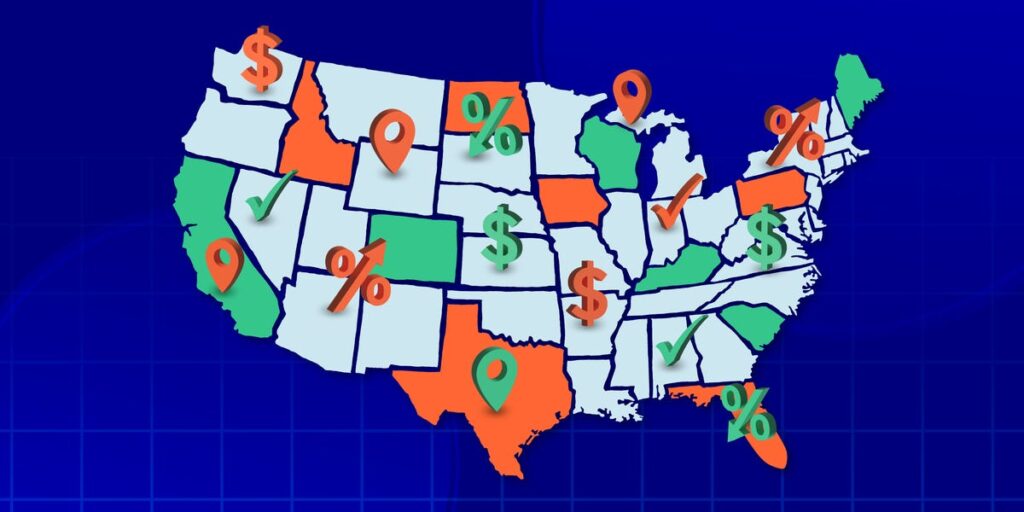
<span class="image-caption-text">Most states have taxes with rates that get progressively higher as your income increases.</span> <span class="image-source-text"> <span class="image-source headline-regular" data-e2e-name="image-source" itemprop="creditText" > Rachel Mendelson/Insider </span> </span>
Affiliate links for the products on this page are from partners that compensate us and terms apply to offers listed (see our advertiser disclosure with our list of partners for more details). However, our opinions are our own. See how we rate products and services to help you make smart decisions with your money.
- Many of the 50 states and Washington, D.C., collect some sort of personal income tax.
- Nine states either don’t levy income tax at all or only collect it on interest and dividend income from investments.
- States that do assess income taxes either use a flat rate or a progressive tax system.
While people across the United States pay federal income taxes, depending on where you live, you may also be subject to state income taxes.
The rates vary widely from one state to the next. And there are two different ways to impose them: flat tax rates and graduated tax rates.
The states with the highest income tax rates all have graduated tax rates:
- California (13.3% top marginal tax rate)
- Hawaii (11% top marginal tax rate)
- New York (10.9% top marginal tax rate).
The states with the lowest income tax rates are a mix of flat tax and graduated tax rates:
- North Dakota (2.5% top marginal tax rate)
- Arizona (2.5% flat tax rate)
- Indiana (3.05% flat tax rate)
Taxpayers who itemize their deductions can deduct state income taxes on their federal tax returns.
States with no income tax
You won’t have to pay any state income tax in Alaska, Florida, Nevada, South Dakota, Texas, Washington, or Wyoming.
Until recently, Tennessee only taxed income from investment earnings on bonds and stock, not income earned at a job. But that tax was repealed starting in the 2021 tax year.
New Hampshire doesn’t tax W-2 income, and its levy on investment income is being phased out in 1 percentage point increments each year until it’s fully repealed for tax years after 2026.
Washington levies a 7% tax on capital gains income over $250,000.
It may seem ideal to live in a state with no income tax, but they often make up the difference elsewhere, such as sales and property taxes.
States with flat income tax rates
A flat tax collects the same percentage of income from all taxpayers, regardless of their income level.
For example, someone who lives in Colorado is going to pay 4.5% of their taxable income in taxes to the state — whether it’s someone earning $100,000 who pays $4,500 or someone earning $10,000 who pays $450.
States tend to have flat tax rates because they’re believed to be simpler to administer and regulate, according to Davis. “These states often allow fewer deductions and write-offs than states with a progressive system,” he says.
2024 rates for states with flat income tax systems
Source: Tax Foundation
States with progressive income tax rates
Graduated, or progressive tax rates, use a series of income thresholds called brackets to assess taxes.
“Progressive tax systems are more common and apply a higher tax rate to higher earners,” says Tyler Davis, a CPA with Simplify LLC, which provides free resources for small business owners. “The more you make, the higher your tax rate is.”
The argument for graduated tax rates is that they’re tied to your income so those who earn more pay more. A flat tax, on the other hand, can have a disproportionate impact on low-income taxpayers.
2024 rates for states with graduated income tax systems
Source: Tax Foundation
Note: Connecticut and New York practice tax-benefit recapture, where some high earners pay the top tax rate on all of their eligible income.
Factors affecting state income tax rates
How much you pay in income tax to your state depends on various factors, including:
- Income level: In states with a progressive tax system, higher income generally results in a higher tax liability.
- Filing status: Like the federal government, many state governments use different tax brackets and deductions for people who are single, married, and primary caregivers.
- Residency: If you split your time between two or more states, you’ll typically need to file a return in each state. You’ll get a credit for taxes paid to other states on your resident state return so you aren’t double-taxed.
- Deductions and credits: Various deductions and credits may be available that can help lower your tax liability.
How to find your state’s income tax rates
State department of revenue websites
The IRS maintains a list of state government websites where taxpayers can find information about filing, paying, and calculating taxes.
Tax preparation software
The best tax software allows you to prepare your state return in addition to your federal return for an additional fee, and can help navigate with state-specific rules and deductions.
Tax professional
For personalized help with state taxes, consult a local professional such as a CPA or tax preparer.
FAQs on state income tax rates
If you work in a different state than where you live, you may have to file state returns in any state where you have earned income. However, you’ll get a credit for taxes paid to other states than your primary residence, so you won’t pay state income tax twice. In general, you’ll only be taxed on income in the state where you live, not the state where you work.
To estimate your state income tax liability, find the income tax tables on your state’s department of revenue website or consult a local CPA.
Yes, you can deduct state income and local taxes you paid if you itemize deductions. There is a $10,000 annual limit on the deduction.




